工程光学英文作业详解(郁道银版 十五章全)
- 格式:pdf
- 大小:529.84 KB
- 文档页数:13
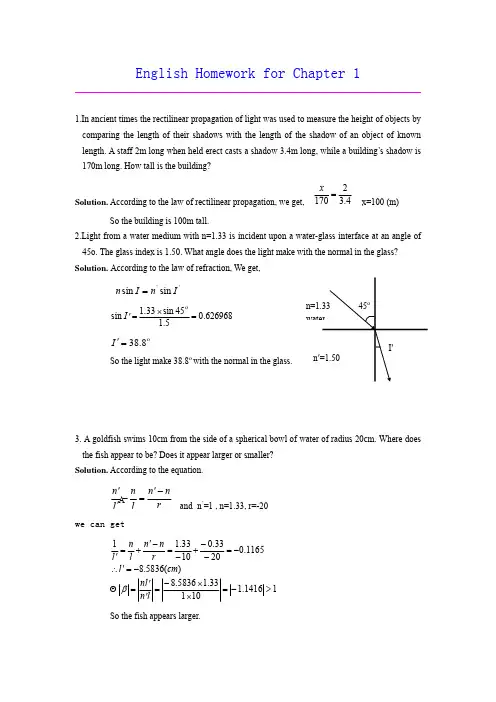
![工程光学_郁道银_光学习题解答[1]](https://uimg.taocdn.com/299f87cca1c7aa00b52acbe1.webp)
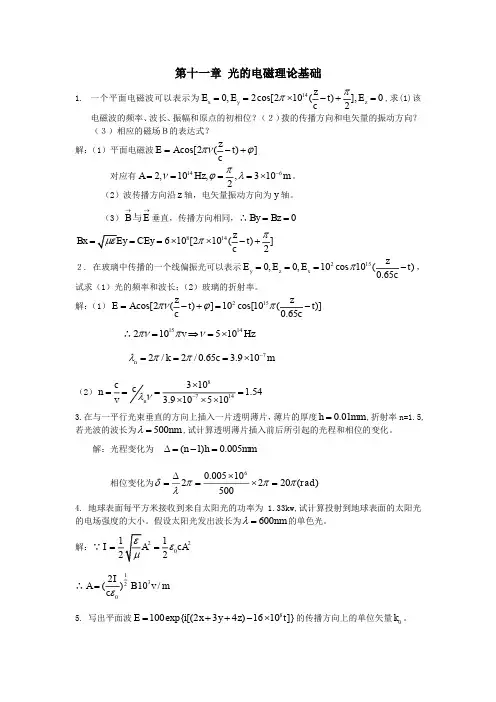
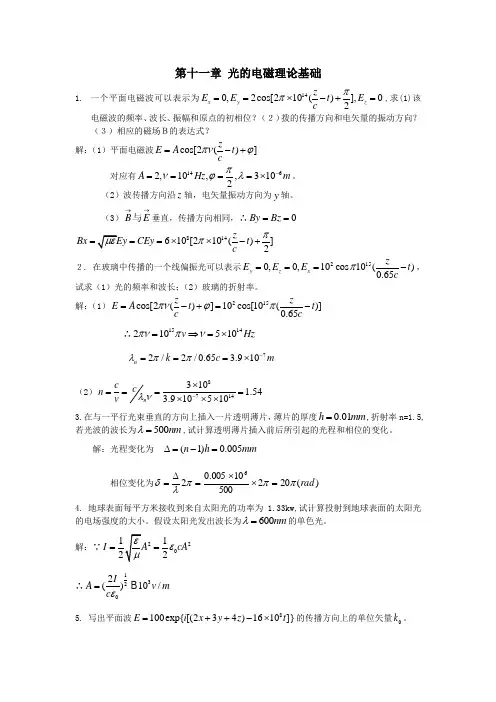
第十一章 光的电磁理论基础1. 一个平面电磁波可以表示为140,2cos[210()],02x y z z E E t E cππ==⨯-+=,求(1)该电磁波的频率、波长、振幅和原点的初相位?(2)拨的传播方向和电矢量的振动方向?(3)相应的磁场B的表达式?解:(1)平面电磁波cos[2()]zE A t cπνϕ=-+ 对应有1462,10,,3102A Hz m πνϕλ-====⨯。
(2)波传播方向沿z 轴,电矢量振动方向为y 轴。
(3)B E →→与垂直,传播方向相同,∴0By Bz ==814610[210()]2z Bx CEy t c ππ===⨯⨯-+2. 在玻璃中传播的一个线偏振光可以表示2150,0,10cos 10()0.65y z x zE E E t cπ===-,试求(1)光的频率和波长;(2)玻璃的折射率。
解:(1)215cos[2()]10cos[10()]0.65z zE A t t ccπνϕπ=-+=- ∴1514210510v Hz πνπν=⇒=⨯72/2/0.65 3.910n k c m λππ-===⨯(2)8714310 1.543.910510n c c n v λν-⨯====⨯⨯⨯ 3.在与一平行光束垂直的方向上插入一片透明薄片,薄片的厚度0.01h mm =,折射率n=1.5,若光波的波长为500nm λ=,试计算透明薄片插入前后所引起的光程和相位的变化。
解:光程变化为 (1)0.005n h mm ∆=-=相位变化为)(20250010005.026rad πππλδ=⨯⨯=∆= 4. 地球表面每平方米接收到来自太阳光的功率为 1.33kw,试计算投射到地球表面的太阳光的电场强度的大小。
假设太阳光发出波长为600nm λ=的单色光。
解:∵22012I cA ε== ∴1322()10/I A v m c ε=5. 写出平面波8100exp{[(234)1610]}E i x y z t =++-⨯的传播方向上的单位矢量0k 。

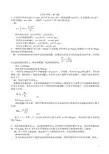
工程光学第一章习题1、已知真空中的光速c=3 m/s,求光在水(n=1.333)、冕牌玻璃(n=1.51)、火石玻璃(n=1.65)、加拿大树胶(n=1.526)、金刚石(n=2.417)等介质中的光速。
解:则当光在水中,n=1.333时,v=2.25 m/s,当光在冕牌玻璃中,n=1.51时,v=1.99 m/s,当光在火石玻璃中,n=1.65时,v=1.82 m/s,当光在加拿大树胶中,n=1.526时,v=1.97 m/s,当光在金刚石中,n=2.417时,v=1.24 m/s。
2、一物体经针孔相机在屏上成一60mm大小的像,若将屏拉远50mm,则像的大小变为70mm,求屏到针孔的初始距离。
解:在同种均匀介质空间中光线直线传播,如果选定经过节点的光线则方向不变,令屏到针孔的初始距离为x,则可以根据三角形相似得出:所以x=300mm即屏到针孔的初始距离为300mm。
3、一厚度为200mm的平行平板玻璃(设n=1.5),下面放一直径为1mm的金属片。
若在玻璃板上盖一圆形纸片,要求在玻璃板上方任何方向上都看不到该金属片,问纸片最小直径应为多少?解:令纸片最小半径为x,则根据全反射原理,光束由玻璃射向空气中时满足入射角度大于或等于全反射临界角时均会发生全反射,而这里正是由于这个原因导致在玻璃板上方看不到金属片。
而全反射临界角求取方法为:(1)其中n2=1, n1=1.5,同时根据几何关系,利用平板厚度和纸片以及金属片的半径得到全反射临界角的计算方法为:(2)联立(1)式和(2)式可以求出纸片最小直径x=179.385mm,所以纸片最小直径为358.77mm。
4、光纤芯的折射率为n1、包层的折射率为n2,光纤所在介质的折射率为n0,求光纤的数值孔径(即n0sinI1,其中I1为光在光纤内能以全反射方式传播时在入射端面的最大入射角)。
解:位于光纤入射端面,满足由空气入射到光纤芯中,应用折射定律则有:n0sinI1=n2sinI2 (1)而当光束由光纤芯入射到包层的时候满足全反射,使得光束可以在光纤内传播,则有:(2)由(1)式和(2)式联立得到n0 sinI1 .5、一束平行细光束入射到一半径r=30mm、折射率n=1.5的玻璃球上,求其会聚点的位置。
![工程光学_郁道银_光学习题解答[1]](https://uimg.taocdn.com/5edf90ada76e58fafab003df.webp)
第一章习题1、已知真空中的光速c=3 m/s,求光在水(n=1.333)、冕牌玻璃(n=1.51)、火石玻璃(n=1.65)、加拿大树胶(n=1.526)、金刚石(n=2.417)等介质中的光速。
解:则当光在水中,n=1.333时,v=2.25 m/s,当光在冕牌玻璃中,n=1.51时,v=1.99 m/s,当光在火石玻璃中,n=1.65时,v=1.82 m/s,当光在加拿大树胶中,n=1.526时,v=1.97 m/s,当光在金刚石中,n=2.417时,v=1.24 m/s。
2、一物体经针孔相机在屏上成一60mm大小的像,若将屏拉远50mm,则像的大小变为70mm,求屏到针孔的初始距离。
解:在同种均匀介质空间中光线直线传播,如果选定经过节点的光线则方向不变,令屏到针孔的初始距离为x,则可以根据三角形相似得出:所以x=300mm即屏到针孔的初始距离为300mm。
3、一厚度为200mm的平行平板玻璃(设n=1.5),下面放一直径为1mm的金属片。
若在玻璃板上盖一圆形纸片,要求在玻璃板上方任何方向上都看不到该金属片,问纸片最小直径应为多少?解:令纸片最小半径为x,则根据全反射原理,光束由玻璃射向空气中时满足入射角度大于或等于全反射临界角时均会发生全反射,而这里正是由于这个原因导致在玻璃板上方看不到金属片。
而全反射临界角求取方法为:(1)其中n2=1, n1=1.5,同时根据几何关系,利用平板厚度和纸片以及金属片的半径得到全反射临界角的计算方法为:(2)联立(1)式和(2)式可以求出纸片最小直径x=179.385mm,所以纸片最小直径为358.77mm。
4、光纤芯的折射率为n1、包层的折射率为n2,光纤所在介质的折射率为n0,求光纤的数值孔径(即n0sinI1,其中I1为光在光纤内能以全反射方式传播时在入射端面的最大入射角)。
解:位于光纤入射端面,满足由空气入射到光纤芯中,应用折射定律则有:n0sinI1=n2sinI2 (1)而当光束由光纤芯入射到包层的时候满足全反射,使得光束可以在光纤内传播,则有:(2)由(1)式和(2)式联立得到n0 sinI1 .5、一束平行细光束入射到一半径r=30mm、折射率n=1.5的玻璃球上,求其会聚点的位置。

4、光纤芯的折射率为n1、包层的折射率为n2,光纤所在介质的折射率为n, 求光纤的数值孔径( 即n0sinI1,其中I1为光在光纤内能以全反射方式传播时在入射端面的最大入射角) 。
解: 位于光纤入射端面, 满足由空气入射到光纤芯中, 应用折射定律则有:n0sinI1=n2sinI2(1)而当光束由光纤芯入射到包层的时候满足全反射, 使得光束能够在光纤内传播, 则有:(2)由( 1) 式和( 2) 式联立得到nsinI1 .5、一束平行细光束入射到一半径r=30mm、折射率n=1.5的玻璃球上, 求其会聚点的位置。
如果在凸面镀反射膜, 其会聚点应在何处? 如果在凹面镀反射膜, 则反射光束在玻璃中的会聚点又在何处? 反射光束经前表面折射后, 会聚点又在何处? 说明各会聚点的虚实。
解: 该题能够应用单个折射面的高斯公式来解决,设凸面为第一面, 凹面为第二面。
( 1) 首先考虑光束射入玻璃球第一面时的状态, 使用高斯公式:会聚点位于第二面后15mm处。
( 2) 将第一面镀膜, 就相当于凸面镜像位于第一面的右侧, 只是延长线的交点, 因此是虚像。
还能够用β正负判断:( 3) 光线经过第一面折射: , 虚像第二面镀膜,则:得到:( 4) 再经过第一面折射物像相反为虚像。
6、一直径为400mm, 折射率为1.5的玻璃球中有两个小气泡, 一个位于球心, 另一个位于1/2半径处。
沿两气泡连线方向在球两边观察, 问看到的气泡在何处? 如果在水中观察, 看到的气泡又在何处?解: 设一个气泡在中心处, 另一个在第二面和中心之间。
( 1) 从第一面向第二面看( 2) 从第二面向第一面看( 3) 在水中7、有一平凸透镜r1=100mm,r2=,d=300mm,n=1.5,当物体在时, 求高斯像的位置l’。
在第二面上刻一十字丝, 问其经过球面的共轭像在何处? 当入射高度h=10mm, 实际光线的像方截距为多少? 与高斯像面的距离为多少?解:8、一球面镜半径r=-100mm,求=0 , -0.1 , -0.2 , -1 , 1 , 5, 10, ∝时的物距像距。
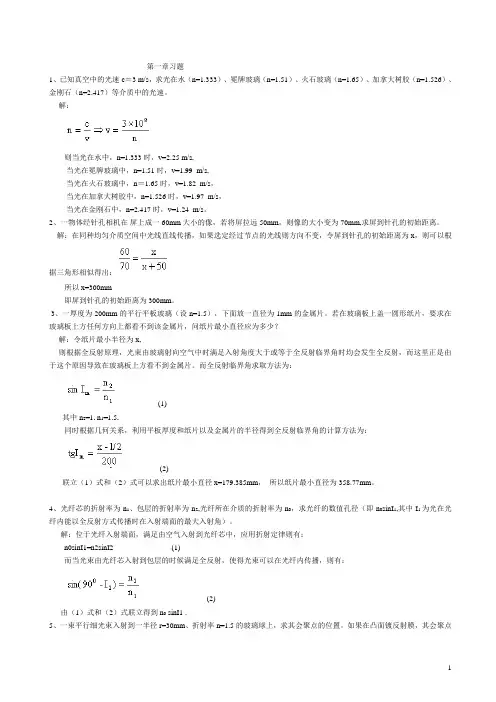
第一章习题1、已知真空中的光速c=3 m/s,求光在水(n=1.333)、冕牌玻璃(n=1.51)、火石玻璃(n=1.65)、加拿大树胶(n=1.526)、金刚石(n=2.417)等介质中的光速。
解:则当光在水中,n=1.333时,v=2.25 m/s,当光在冕牌玻璃中,n=1.51时,v=1.99 m/s,当光在火石玻璃中,n=1.65时,v=1.82 m/s,当光在加拿大树胶中,n=1.526时,v=1.97 m/s,当光在金刚石中,n=2.417时,v=1.24 m/s。
2、一物体经针孔相机在屏上成一60mm大小的像,若将屏拉远50mm,则像的大小变为70mm,求屏到针孔的初始距离。
解:在同种均匀介质空间中光线直线传播,如果选定经过节点的光线则方向不变,令屏到针孔的初始距离为x,则可以根据三角形相似得出:所以x=300mm即屏到针孔的初始距离为300mm。
3、一厚度为200mm的平行平板玻璃(设n=1.5),下面放一直径为1mm的金属片。
若在玻璃板上盖一圆形纸片,要求在玻璃板上方任何方向上都看不到该金属片,问纸片最小直径应为多少?解:令纸片最小半径为x,则根据全反射原理,光束由玻璃射向空气中时满足入射角度大于或等于全反射临界角时均会发生全反射,而这里正是由于这个原因导致在玻璃板上方看不到金属片。
而全反射临界角求取方法为:(1)其中n2=1, n1=1.5,同时根据几何关系,利用平板厚度和纸片以及金属片的半径得到全反射临界角的计算方法为:(2)联立(1)式和(2)式可以求出纸片最小直径x=179.385mm,所以纸片最小直径为358.77mm。
4、光纤芯的折射率为n1、包层的折射率为n2,光纤所在介质的折射率为n0,求光纤的数值孔径(即n0sinI1,其中I1为光在光纤内能以全反射方式传播时在入射端面的最大入射角)。
解:位于光纤入射端面,满足由空气入射到光纤芯中,应用折射定律则有:n0sinI1=n2sinI2 (1)而当光束由光纤芯入射到包层的时候满足全反射,使得光束可以在光纤内传播,则有:(2)由(1)式和(2)式联立得到n0 sinI1 .5、一束平行细光束入射到一半径r=30mm、折射率n=1.5的玻璃球上,求其会聚点的位置。
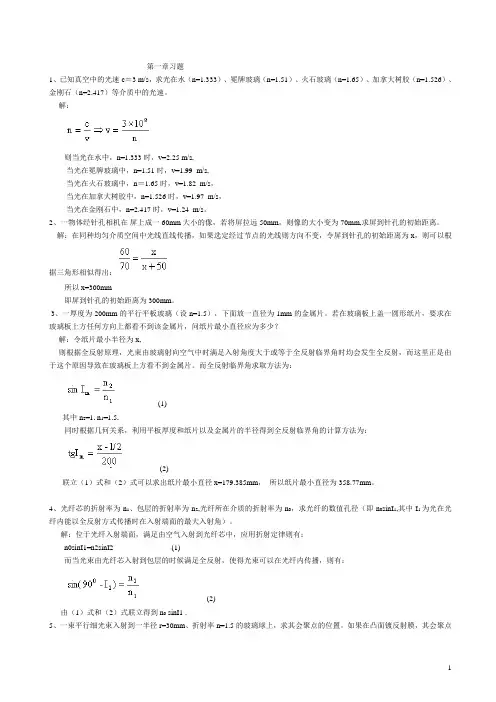
第一章习题1、已知真空中的光速c=3 m/s,求光在水(n=1.333)、冕牌玻璃(n=1.51)、火石玻璃(n=1.65)、加拿大树胶(n=1.526)、金刚石(n=2.417)等介质中的光速。
解:则当光在水中,n=1.333时,v=2.25 m/s,当光在冕牌玻璃中,n=1.51时,v=1.99 m/s,当光在火石玻璃中,n=1.65时,v=1.82 m/s,当光在加拿大树胶中,n=1.526时,v=1.97 m/s,当光在金刚石中,n=2.417时,v=1.24 m/s。
2、一物体经针孔相机在屏上成一60mm大小的像,若将屏拉远50mm,则像的大小变为70mm,求屏到针孔的初始距离。
解:在同种均匀介质空间中光线直线传播,如果选定经过节点的光线则方向不变,令屏到针孔的初始距离为x,则可以根据三角形相似得出:所以x=300mm即屏到针孔的初始距离为300mm。
3、一厚度为200mm的平行平板玻璃(设n=1.5),下面放一直径为1mm的金属片。
若在玻璃板上盖一圆形纸片,要求在玻璃板上方任何方向上都看不到该金属片,问纸片最小直径应为多少?解:令纸片最小半径为x,则根据全反射原理,光束由玻璃射向空气中时满足入射角度大于或等于全反射临界角时均会发生全反射,而这里正是由于这个原因导致在玻璃板上方看不到金属片。
而全反射临界角求取方法为:(1)其中n2=1, n1=1.5,同时根据几何关系,利用平板厚度和纸片以及金属片的半径得到全反射临界角的计算方法为:(2)联立(1)式和(2)式可以求出纸片最小直径x=179.385mm,所以纸片最小直径为358.77mm。
4、光纤芯的折射率为n1、包层的折射率为n2,光纤所在介质的折射率为n0,求光纤的数值孔径(即n0sinI1,其中I1为光在光纤内能以全反射方式传播时在入射端面的最大入射角)。
解:位于光纤入射端面,满足由空气入射到光纤芯中,应用折射定律则有:n0sinI1=n2sinI2 (1)而当光束由光纤芯入射到包层的时候满足全反射,使得光束可以在光纤内传播,则有:(2)由(1)式和(2)式联立得到n0 sinI1 .5、一束平行细光束入射到一半径r=30mm、折射率n=1.5的玻璃球上,求其会聚点的位置。
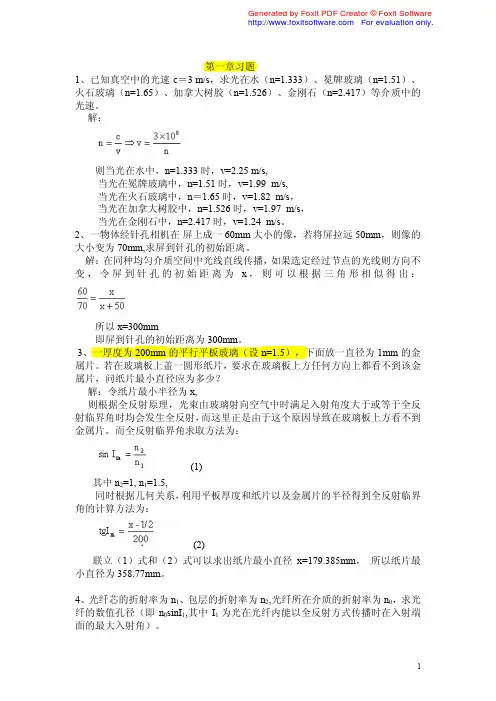
工程光学英文版课后练习题含答案IntroductionEngineering Optics is a branch of optics that studies the application of optical principles and devices to solve engineering problems, including optical design, imaging systems, and measurement techniques. As an important part of Engineering Optics, the homework exercises help students understand the theoretical knowledge and familiarize themselves with practical problems. In this document, we provide a set of homework exercises with answers for Engineering Optics, which are designed to help students review the knowledge they learned in class and prepare for exams.Chapter 1: Introduction1.What is the definition of light?–Light is an electromagnetic wave that travels through space and has both electric and magneticcomponents perpendicular to each other and to thedirection of propagation.2.What are the primary properties of light?–The primary properties of light include reflection, refraction, diffraction, interference,and polarization.3.What is the difference between coherent andincoherent light?–Coherent light is light that has a constant phase relationship between two or more waves, whileincoherent light is light that has a random phaserelationship between two or more waves.4.What is the difference between monochromatic andpolychromatic light?–Monochromatic light consists of a single wavelength, while polychromatic light consists ofmultiple wavelengths.5.Define dispersion.–Dispersion is the phenomenon of different wavelengths of light traveling at different speedsthrough a medium, leading to a separation of thecolors of light.Chapter 2: Geometrical Optics1.Define ray and expln how rays are used ingeometrical optics.–A ray is an idealized model of the path that light travels through space, represented as a linewith an arrow indicating the direction ofpropagation. Rays are used in geometrical optics to determine the behavior of light as it passesthrough lenses, mirrors, and other optical devices.2.Define optical axis and principal plane.–The optical axis is the imaginary line passing through the center of curvature of a sphericallysymmetric optical system. The principal plane isthe plane perpendicular to the optical axis thatpasses through the focal point of the system.3.Define focal length and expln how it relates to the curvature of a lens.–The focal length is the distance between the center of curvature of a lens and the point whereparallel rays of light converge after passingthrough the lens. The curvature of a lensdetermines its focal length.4.Define the focal plane and expln how it relates to the focal length.–The focal plane is the plane perpendicular to the optical axis that passes through the focalpoint of a lens or mirror. The distance from thelens or mirror to the focal plane is equal to thefocal length.5.Expln the concept of conjugate planes.–Conjugate planes are prs of object and image planes that are related by an optical system suchthat an object in one plane is imaged onto theother plane. The distance between the two planes isequal to the sum of the object distance and imagedistance.Chapter 3: Optical Instruments1.Define the resolving power of an optical system.–The resolving power of an optical system is its ability to distinguish two closely spacedobjects as separate entities. It is determined bythe numerical aperture and wavelength of the lightused in the system.2.Define the magnification of an optical system.–The magnification of an optical system is the ratio of the size of the image produced by thesystem to the size of the object being imaged.3.What is a camera and how does it work?–A camera is an optical instrument that uses a lens to focus an image onto a light-sensitivesurface, such as film or a digital sensor. Theimage is formed by the interaction of light withthe surface, creating a chemical or electronicpattern that can be developed into a visible image.4.What is a microscope and how does it work?–A microscope is an optical instrument that uses a lens or a series of lenses to magnify small objects that cannot be seen with the naked eye. The specimen is placed on a stage and illuminated witha light source, and the image is formed by lensesthat focus the light onto the observer’s eye or a camera sensor.5.What is a telescope and how does it work?–A telescope is an optical instrument that usesa lens or a mirror or a combination of both tocollect and focus light from distant objects, such as stars, galaxies, or planets. The image is formed by lenses that magnify the light and focus it onto the observer’s eye or a camera sensor.ConclusionIn conclusion, the homework exercises and answers provided in this document are intended to help students review key concepts and prepare for exams in Engineering Optics. By solving these problems, students can deepen their understanding of optical principles and devices and develop their problem-solving skills. We hope that this resource will be useful for students and instructors alike in the study of Engineering Optics.。
天津大学《工程光学Ⅰ》课程教学大纲课程代码:2020015课程名称:工程光学Ⅰ学时:48学分:3授课:48 上机:实验:实践:实践学时分配:(周):授课学院:精仪学院更新时间:2011年12月适用专业:生物医学工程先修课程:高等数学,大学物理一、课程的性质与目的本课程是一门基础课,主要讲授几何光学、物理光学和现代光学方面的基本理论、基本方法和典型光学元件、系统实例及应用。
通过本课程的学习,学生应能理解光的本质特性,了解各种光学现象及对应的基本原理,熟悉常见光学元件和典型系统,为学习生物光子学、医用光学仪器和从事光学研究打下坚实的基础。
二、教学基本要求任课教师应尽可能充分利用多媒体课件、课程网站等现有教学资源,根据实际条件开展不同程度的双语教学实践;课堂教学后,要留一定数量的作业题,并坚持批改1/3,以利掌握学生的学习情况;学生应按要求参加全部的课堂教学活动,按要求完成作业;参加期末考试,获得该课程学分。
通过本课程的学习,要求达到:1.系统掌握几何光学的基础理论,包括基本定律、成像相关表述、理想光学系统理论。
2.掌握典型的光学系统,包括放大系统、显微系统和望远系统。
3.掌握光的电磁理论及光波叠加的相关知识。
4.掌握光的干涉、衍射、偏振的理论和计算。
5.了解现代光学系统。
三、教学内容绪论1.学习《工程光学》的意义和重要性(光学发展的历史,对国民经济发展的重要作用,光学在生物医学工程领域的应用)2.本课程的性质、任务和内容3.学习的基本要求、教学环节和学习方法第1章几何光学基本定律与成像概念1.几何光学基本定律:1)光的直线传播定律 2)光的独立传播定律 3)反射定律和折射定律(全反射及其应用) 4)光路的可逆性 5)费马原理(最短光程原理) 6)马吕斯定律:2.完善成像条件的概念和相关表述3.应用光学中的符号规则,单个折射球面的光线光路计算公式(近轴、远轴)4.单个折射面的成像公式,包括垂轴放大率、轴向放大率、角放大率γ、拉赫不变量等公式。
English Homework for Chapter 11.In ancient times the rectilinear propagation of light was used to measure the height of objects by comparing the length of their shadows with the length of the shadow of an object of known length. A staff 2m long when held erect casts a shadow 3.4m long, while a building’s shadow is 170m long. How tall is the building?Solution. According to the law of rectilinear propagation, we get, x=100 (m)So the building is 100m tall.2.Light from a water medium with n=1.33 is incident upon a water-glass interface at an angle of 45o. The glass index is 1.50. What angle does the light make with the normal in the glass?Solution. According to the law of4.32170 xrefraction, We get,So the light makenormal in the glass.3. A goldfish swims 10cm from the side of a spherical bowl of water of radius 20cm. Where does the fish appear to be? Does it appear larger or smaller?Solution. According to the equation. and n ’=1 , n=1.33, r=-20we can getSo the fish appears larger.''sin sin I n I n =626968.05.145sin 33.1sin =⨯='I8.38='I rn n l n l n -'=-''11416.110133.15836.8)(5836.81165.02033.01033.11>-=⨯⨯-=''=-='∴-=--+-=-'+='l n l n cm l r n n l n l β n A4.An object is located 2cm to the left of convex end of a glass rod which has a radius of curvature of 1cm. The index of refraction of the glass is n=1.5. Find the image distance.Solution. Refer to the figure. According to the equationand n=1, n ’=1.5, l 1=-2cm,rn n l n l n -'=-''r 1=1cm , we getEnglish Homework for Chapter 21.An object 1cm high is 30cm in front of a thin lens with a focal length of 10cm. Where is the image? Verify your answer by graphical construction of the image. Solution. According toequation, and l=-30cm f ’we getOthers are omitted.cm l l d l l l 2021115.15.121211='∴-∞='-=∞='∴=-+-='f l l '=-'11)(15)30(10)30(10cm l f l f l =-+-⨯=+''='′′′2.A lens is known to have a focal length of 30cm in air. An object is placed 50cm to the left of the lens. Locate the image and characterize it.Solution.and f′=30cm l we getThe image is a real, larger one.3.The object is transparent cube, 4mm across, placed 60cm in front of 20cm focal length. Calculate the transverse and axial magnification and describe what the image looks like?Solution. From Gauss’s equation, we find for the rear surface of the cube (the face closer to the lens)that,f l l '=-'11(75)50(30)50(30l f l f l =-+-⨯=+''='5.15075-=-='=l l β)(3020)60()20()60(111cm f l f l l +=+-⨯-='+'='′For the front surface (the face farther away from the lens),The transverse magnification for the rear surface isBut the axial magnification isSince ,the cube doesn’t look likea cube.4.A biconvex lens is made out of glass of n=1.52. If one surface has twice the radius of curvature of the other, and if the focal length is 5cm, what are the two radii?Solution. Supposing r 1= -2r 2 (ρ2=-2ρ1),according to the lens equationwe get,∴r 1=7.8(cm) r 2=-3.9(cm))(9.29204.6020)4.60(2cm l +=+-⨯-='⨯-=-+=5.06030t M ⨯+=----=∆'∆=25.0)4.60(609.2930l l M a atM M ≠))(1(21ρρϕ--=n )(152.1(51ρ-=1282.01=∴ρ2564.02-=ρ返回English Homework for Chapter 4 1. A stop 8mm in diameter is placed halfway between an extended object and a large-diameter lens of 9cm focal length. The lens projects an image of the object onto a screen 14cm away. What is the diameter of the exit pupil?Solution. Refer to the figure. First, from the known focal length and the image distance,we find the object distance. and l ’=14 f ’=9l =-25.2(cm)The stop is one-half that distance is front of the lens, so l s =12.6(cm)∴l s ’=31.5(cm)∴2. Two lenses, a lens of 12.5cm focal length and a minus lens of unknownf l l '=-'11122.255.31-='==ss stop ex l l D D β )(28.05.2cm D ex=⨯=power, are mounted coaxially and 8 cm apart. The system is a focal, that is light entering the system parallel at one side emerges parallel at the other. If a stop 15mm in diameter is placed halfway between the lenses:1) Where is the entrance pupil?2) Where is the exit pupil?3) What are their diameters?’Solution. Refer to the figure. For thesystem to be a focal, the focal points of the two lenses mustcoincide. Since f 1’=12.5cm, and the two lenses are 8cm apart, so f 2’=-4.5cm. The entrance pupil is the image of stop formed by the first lens.According to Gauss’s equation,and l 1’=4cm, f 1’=12.5cm. We getThe exit pupil’slocation is返回111111f l l '=-'())(88.55.845.1211111cm l f l f l =⨯='-'''=)(05.22488.5151mm D D stopentrance =⨯==β)(95.715412.2)(12.25.818)4()5.4()4()5.4(222222mm D D cm f l l f l stop exit =⨯=∙=-=-=-+--⨯-='+'='βEnglish Homework for Chapter 71. A person wants to look at the image of his or her own eyes, without accommodation, using a concave mirror of 60cm radius of curvature. How far must the mirror be from the eye if the person has1) Normal vision?2) 4diopter myopia, without correction?3) 4diopter hyperopia, without correction?Solution.1) When the person has normal vision, according to the following scheme 1, we getso,∞='l cm r l 302==Scheme 1and, orSo the mirror must be 75cm or 10cmfrom the eye.and, or (Since the object isreal, so we can give up this answer)So the mirror must be 50cm from theeye.141-=m l r cm l l r 25-=='r l l 211=+' )(25cm l l +'=cm r 60=265852253048585025308522±=⨯⨯-±==⨯+-l l l ⎩⎨⎧==∴)(50')(7511cm l cm l ⎩⎨⎧-==)(15')(1022cm l cm l r l l 211=+' )(25'cm l l +=cm r 60=265352253043535025303522±=⨯⨯+±==⨯--l l l ⎩⎨⎧==∴)(75')(5011cm l cm l ⎩⎨⎧=-=)(10')(1522cm l cm l Scheme 2 Scheme 32. Discussion: What differences between the following situations:1) a microscope is used for projection;2) the microscope is used for visual observation.返回工程光学(上)期末考试试卷一.问答题:(共12分,每题3分)1.摄影物镜的三个重要参数是什么?它们分别决定系统的什么性质?2.为了保证测量精度,测量仪器一般采用什么光路?为什么?3.显微物镜、望远物镜、照相物镜各应校正什么像差?为什么?4.评价像质的方法主要有哪几种?各有什么优缺点?二.图解法求像或判断成像方向:(共18分,每题3分)1.求像A'B'2.求像A'B'3.求物AB经理想光学系统后所成的像,并注明系统像方的基点位置和焦距4.判断光学系统的成像方向5.求入瞳及对无穷远成像时50%渐晕的视场6.判断棱镜的成像方向三.填空:(共10分,每题2分)1.照明系统与成像系统之间的衔接关系为:①________________________________________________②________________________________________________2.转像系统分____________________和___________________两大类,其作用是:_______________________________ __________3.一学生带500度近视镜,则该近视镜的焦距为_________________,该学生裸眼所能看清的最远距离为_________________。